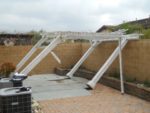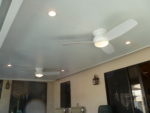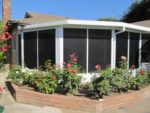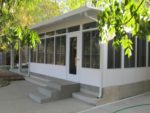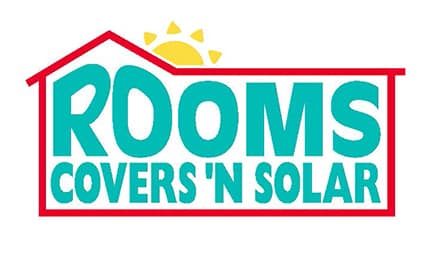Patio Cover Lighting Options

You’ve decided to take the plunge and bring some shade to your backyard. Decisions on the type of patio cover, along with size, height and color, have been made. But, amazingly enough, how you’ll use your patio cover at night is often overlooked. Those summer barbecues and pool parties often go to dusk and beyond…having a good lighting solution can be critical to how much enjoyment you get out of your outdoor space. Let’s break it down into separate zones and types to make it a little easier.
The yard area beyond the patio may or may not need additional lighting from the patio area. Post lights facing outward can supplement whatever landscape lighting is in use, and security lights on motion sensors can also be wired in by a licensed electrician. The post lights can also give some decorative structure to the basic look of the patio cover.
The space underneath the patio cover often has some light, due to it usually being located on the back of the home, hence the back door porch light will give some illumination. This light source is, naturally, behind you most of the time when you are looking out toward your yard. This places shadow on any tasks you might be taking care of (grilling, etc.) because you are between the light source and what you are doing. It also means anyone facing you has the light shining in their eyes..usually an uncomfortable experience. Adding more sources of light will help. Post lights facing inward are a popular choice. They usually aren’t task specific, but are attractive and do spruce up the patio cover. Hooking up multiple fixtures can be a tad complicated…a licensed electrician is always your best bet.
Next we have overhead lighting. There are a few choices here. Dome lights offer an attractive, but single-point light source, and the cover (dome) of the fixture is often frosted, which can dilute the light quite a bit. Several of these, spaced across the patio cover, can be quite attractive. Track lighting is an option, as well. A multi-light fixture can certainly point light where you want it, but a lot of people find these fixtures a bit dated in appearance. A third choice is mounting a fan with a light kit attached beneath it. Since these usually have more than one bulb, the light gets spread around a bit more than with the dome light. Head room comes into play with the fan/light combination if you’re working off of a single story house, however, as code requires 80″ under the lowest point on the fixture.
My favorite lighting option is called TheLightStrip. There are models available for both insulated and non-insulated (flat pan) patio covers, available direct from the company who makes your patio cover. Essentially, TheLightStrip is recessed lighting for your cover. The flat pan version is constructed of the exact same material as the patio cover itself, and the insulated roof panel version is an extruded fixture that locks cleanly between the panels. Two-, three- or four-light models are offered, based on the projection of your cover. Special ordering is available if you want something different from their standard spacing or number of lights. These fixtures really light up your space, look and perform identically to the recessed lighting in your home, and since the lights are recessed, there are no headroom issues at all. They even come with a built-in fan box option! Check out TheLightStrip.com for details.
Patio covers aren’t just for giving shade from the sun. They can define and enhance your outdoor cooking and entertainment areas, both day and night. Make that space warm and inviting with the lighting of your choice. You’ll be happy you did!



